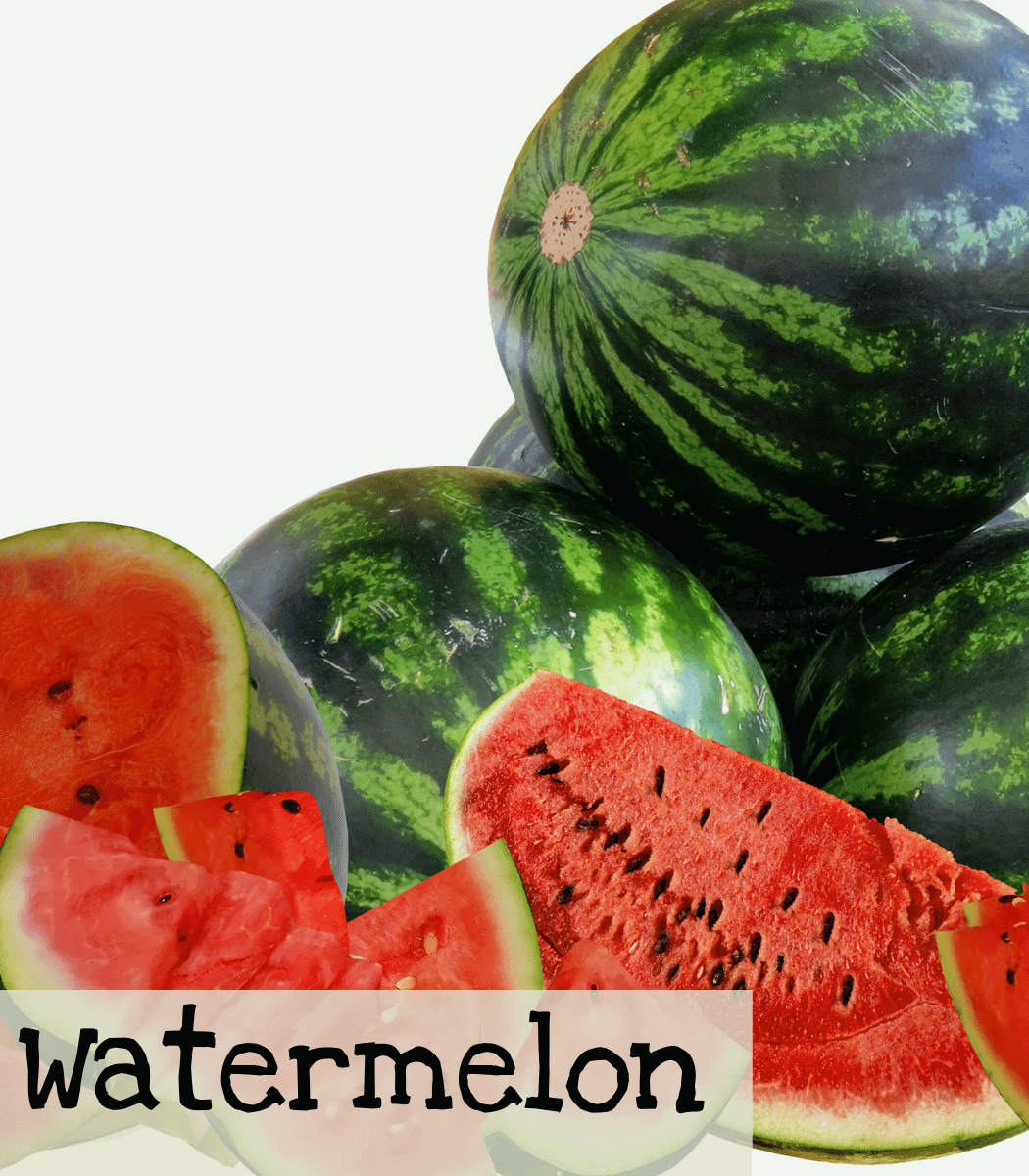
Watermelon
This sweet, water-loving fruit, comes in a wide range of sizes and colors. Watermelon is relatively easy to grow and is a summer favorite.
|
Art Combe’s Ancient; Crimson Sweet*; Royal Golden; Strawberry; Sugar Baby (Bush) |
|
Citrullus lanatus |
|
Easy |
|
Intermediate |
|
5 years if properly cured, cleaned, and stored. |
|
Annual |
|
7-10 days |
|
None |
|
1 inch |
|
Most Watermelon: 10-12′ (24 square feet) Bush Sugar Baby: 3½’ usually bearing 2 fruit per vine. |
|
Full Sun |
|
|
|
|
|
April and May |
|
Yes |

Growing Tips

When to Start
Spring: Direct sow or transplant after the danger of frost has passed and the average soil temperature is 70 F. (Mar 20-May 1 for GA.) You can start them indoors 4-6 weeks before the last frost and transplant them after hardening off and the danger of frost has passed.
How to Start
Watermelons prefer fertile, well-draining but water-retaining soil. Growing watermelons also requires space, as the plants are vines and take up a lot of room. Mix in compost to the bed before planting.
Direct sow 2 seeds 1 inch deep in full sun, after the danger of frost has passed and the average soil temperature is 70 F. Space plants 7-10 feet apart for the larger vines. After seedlings have 2-3 true leaves (leaves which look like watermelon leaves), thin to the strongest seedling.
Care
They are heavy feeders. Use well-composted material and mix it into the soil before planting. Side dress with more well-composted material or use a fertilizer that is designed for vegetables as the season progresses.
You can hand-pollinate flowers to assist in fruit development by transferring pollen from male flowers to female flowers. (Female flowers have a swelling at the bottom.) See Zucchini Pest Prevention for how to hand-pollinate.
Keep the area free from weeds. Good, shallow hoeing is best. You do not want to disturb the roots or cut any shoots off the main plant. You can also use cardboard, mulch, or landscape fabric to reduce and control weeds. Watermelons are mostly water and as such, need plenty of water. Water regularly, evenly, and deeply. Soaker hoses or drip hoses aid with deep watering.
Harvest
As the fruit matures, you can place cardboard underneath it to help keep it clean and dry. Harvest when the tendrils turn yellow and brown, the bottom becomes a buttery yellow or cream and it loses its shine and becomes dull. Leave at least 2 inches of stem on the fruit.
Pest Management
Squash bugs are a particular problem with watermelon. To help control these pests try “Companion Planting” to attract beneficial predators that will eat squash bugs and try “Trap Cropping” to help keep pests out of the watermelon. Squashes like zucchini have similar pest issues. Check out Zucchini Pest Prevention for more tips!
Pro Tip!
Incompatibles: Potatoes
Grows well with: Corn, Radish, Beans, Nasturtiums, Oregano and Marigolds
Seed Saving

Isolation Distance
Watermelons will cross with other melons and varieties should be separated by ½ mile. Watermelons produce wet seeds and should be allowed to ripen past the eating stage on the vine before harvesting since seeds do not continue ripening after they are harvested.
Instructions
Pick after the tendril nearest the melon has completely withered and dried. Store the squash in a cool, dry area for an additional 3 weeks to cure it. Don’t chill it as this will damage the seeds.
Once the watermelon has cured, it’s time to remove the seeds. Cut open the squash and scoop the seeds out. Pour the “guts” into a large bowl and fill it with water. Healthy seed sinks to the bottom and dead (not viable) will float along with the majority of the pulp.
Remove the seeds that float and pulp. Pour the viable seeds into a colander. Rinse off any clinging pulp and drain. Allow the seeds to dry on a towel in a sunny area for a week or so.
Features
- Art Combe’s Ancient: Heirloom. The seeds were found in a clay pot in a cave in the Southwest US. The fruit has a green rind, and the flesh is red and sweet.
- Crimson Sweet: This variety is recommended by the University of Georgia for Georgia growers. Heirloom. Large, round melons that are light green with dark-green stripes. The flesh is dark red, firm, and fine-textured.
- Royal Golden: Heirloom. The rinds turn golden-yellow when ripe. The flesh is red and sweet.
- Strawberry: Heirloom. The fruit is sugary-sweet, with red flesh. It does have some disease tolerance.
- Sugar Baby (Bush): Sweetest, arguably the best-tasting watermelon. It is a bush variety that produces around 2 fruits per vine. The fruit is fine-textured with medium-red flesh.

* Variety is recommended by the University of Georgia.
- Watermelons are what are called ‘heavy feeders.” This means they use up lots of nutrients so you have to replenish the nutrients in the soil. Side dress with compost or use a water-soluble fertilizer that is designed for vegetables. When it is water-soluble the nutrients are immediately available for the plant to take them up.
- Stop watering about 10-14 days before harvest to concentrate the sugars in the fruit.
- Fertilizer designed for vegetables is better than other kinds because it is designed to help the plant produce fruit rather than excessive foliage. Just remember too much of a good thing is a bad thing. Over-fertilizing the watermelon will cause harm and make the plant unhealthy. Yellow leaves can be a sign of too much fertilizer. A good rule of thumb is to fertilize every 10 days. Just adjust depending on the nutrients in the soil and the health of the plant.
You May Also Like:
Zucchini Pest Prevention with How to Hand-Pollinate
Companion Planting: How to use flowers to help control pests.
Trap cropping: How to keep pests out of your main crop.
Sources:
American Horticultural Society Plant Propagation Edited by Alan Toogood
Edenbrothers.com
